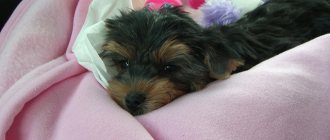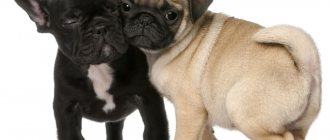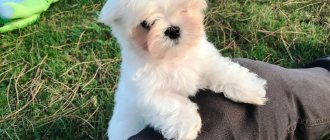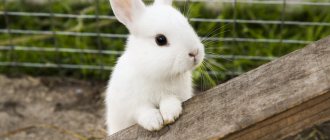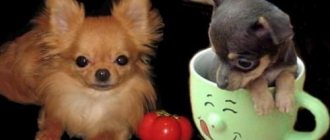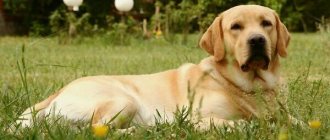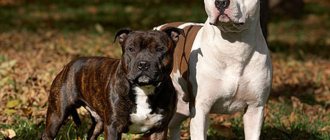Keeping a dog in an apartment
From the point of view of convenience, keeping a German Shepherd in an apartment environment has some difficulties, which is due to the large size of the animal. During a walk, people around them treat such dogs with some distrust and even fear, so to walk a German Shepherd you need to choose specially designated areas or dog areas.
The main rule for properly keeping a German Shepherd dog in an apartment environment is the obligatory allocation of a separate place for the animal in the room. In order to arrange such a place, it is necessary to purchase a bedding with a removable high-quality cover, which must be washed periodically
It is very important to socialize your pet from a very early age, and also teach him not to climb into electrical outlets, not to chew cables or laces, and not to climb on the bed or kitchen furniture.
As a rule, the German Shepherd quickly adapts to the peculiarities of apartment living, and therefore does not require the creation of any special conditions
However, in this case, greater attention should be paid to hygiene rules. German dogs have a very well-defined coat, so preventing the appearance of a very specific smell and clumps of flying hair in the house will only be possible by observing the entire range of hygiene measures.
At what age does estrus stop?
Estrus in German Shepherds does not stop, it becomes less frequent and shorter. After ten years of age, the duration of estrus gradually decreases, as does the period of its onset. But estrus does not completely end until the death of the animal.
Old German Shepherd bitch
Knowing how long estrus lasts in shepherds and what the peculiarities of this process are, the breeder will not be confused when his pet first appears in estrus. Estrus is not a disease, but the bitch’s puberty. With the right exercise, hygiene and sufficient walking, dogs with estrus do not have problems.
Advantages of German Shepherds from reviews from owners and dog handlers
- If you take a puppy into a family that already has a cat or another dog, then perhaps you will end up with a strong tailed family, but an adult shepherd dog has great difficulty accepting new animals.
- A frequent point in descriptions of life with a shepherd from their owners is stories about how the pets follow their tail. At the same time, they are not too lazy to do this all day long, since their energy reserves allow it. They also treat the family quite warmly, but having chosen the owner, they are unconditionally devoted only to him. The breed is tolerant of children, but it is not recommended to allow children to play one-on-one with the dog.
- The show type of German Shepherd is incredibly beautiful. Yes, they are a little inferior to the working type in terms of guard qualities, but for that they look like standard representatives of the breed.
- A shepherd dog that has completed a training course is the best guard. It is not for nothing that the breed is used in military and police service.
- The emotional mobility of the breed is noted by the owners as a definite plus. The dog has a reaction and even an opinion to everything; it can be seen that he is interested in the process of playing and training, or something is bothering him. In everyday life, this aspect takes on sweeter colors; some even note in their reviews that the pet behaves like a human and understands everything.
- A purebred German is the key to success at exhibitions and in sports disciplines. Owners of both show-class and working dogs note the high performance of the breeding pack in matters of the show ring, success on the grounds and as a service dog.
https://youtube.com/watch?v=9tLR8298J2Q
Features of care and maintenance
The German Shepherd does not require special care.
- You need to give your dog a thorough bath several times a year.
- During shedding, the fur is carefully combed using a special brush.
- Ears should be cleaned with a slightly damp swab.
- To clean your teeth, you should purchase special bones with fluoride.
German Shepherds exude energy, so daily walks should last about 2 hours. For lovers of morning jogging, such a dog will be a good companion.
Features of feeding
The puppy's bowl should be placed on a raised surface so that it is at chest level. This method of feeding will contribute to the correct formation of the exterior.
Too cold or hot food can lead to dire consequences.
Starting from 2 months of age, the dog can be given veal cartilage and soft raw bones. Sometimes raw potatoes are given, which has a beneficial effect on the coat.
Since the puppy is growing rapidly, he needs to be given food frequently: from 6 times a day (up to 1.5 months of age), gradually reducing to 2 times (when he is 6 months old).
The diet can be natural (raw meat, bones, boiled fish, vegetables) or balanced dry, preferably premium.
Shepherd dogs - rescuers, guards and search dogs
What is estrus
Estrus is a bloody discharge from the loop, which indicates that everything is normal with the reproductive system and the pet is ready for fertilization. The frequency of the process is 2 times a year. The time between estrus is called anestrus, lasting from 5 to 8 months, followed by proestrus, this is the time of active preparation of the body. Externally the bitch is changing, signs:
- The loop increases, layered discharge appears;
- The girl begins to mark - to go to the toilet often and a little at a time;
- There may be a change in mood - increased aggression or, on the contrary, apathy;
- Showing interest in male dogs, making all sorts of advances.
The preparation time is from 7 to 10 days, after which full estrus occurs (heavy discharge), the dog behaves unrestrained, runs away and looks out for males.
External signs
- The loop is maximally enlarged, the discharge is not abundant, light;
- The girl is being set up for mating.
The most important thing happens in the body - preparing the environment for conception. At the moment of ovulation, fertilization occurs. Duration is from 5 to 8 days, mating time is 2 to 4 days, when ovulation occurs.
Afterwards there is a change to metestrus, the formation of the corpus luteum begins. The girl becomes flexible, obedient, behaves restrained and calm. At this moment she may be pregnant if mating has taken place.
There is such a thing as a “false pregnancy”: a dog after estrus begins to behave as if it is expecting offspring, at this time the nipples swell and the mammary glands enlarge.
Intervals between heats should be within 5 to 7 months, sometimes it can be as late as 8 months. In total, there are about 2 heats per year; during the maturation period up to 2 years, the frequency may not be stable, so it is not recommended to breed a young bitch for cycles 1 and 2.
Nuances of keeping and caring for a German Shepherd
When deciding to get a German, be prepared for the fact that you will have to devote a lot of time and attention to your pet. Dogs need daily walks and regular exercise. Animal hair that is thick and prone to matting requires careful care. Finally, the owner must take care of the German Shepherd's proper and balanced diet.
Keeping German Shepherds
Unpretentious Germans easily adapt to any living conditions. Therefore, the dog can be kept both in an apartment and in a private house. Naturally, a pet will be more comfortable in a house with a vast territory, where he can run and frolic to his heart's content.
But even in a small apartment, the dog will feel comfortable, provided that you provide him with the physical activity he needs and long walks.
If a German is kept in the yard, a spacious enclosure with an insulated booth will be equipped for him.
Pet care rules
- The main disadvantage of the German breed is that the dogs shed heavily all year round. Also, their fur gets tangled and rolls into tangles, which spoils the appearance of the pet. Therefore, the dog needs to be combed once every 2-3 days, and during the period of intense shedding (beginning of spring and autumn), the combing procedure is carried out daily;
- Germans are bathed no more than 2-3 times a year, using a special shampoo for large, wire-haired breeds of dogs;
- periodically inspect the pet's ears and remove dirt with a cotton swab (not a swab). The eyes are also regularly cleaned of discharge using a damp cotton pad;
- if the dog lives in an apartment, his nails are trimmed 1-2 times a month. When kept outdoors, dogs' claws grind down on their own, and such a procedure is not necessary;
- To remove plaque and prevent the formation of tartar, animals' teeth are brushed several times a week.
Your choice is bitch
Bitches are usually shorter, more graceful, lighter and more agile. The head is outlined with smooth, feminine lines, and the body is more stretched due to the elongated lower back. Wool is softer and finer. However, sometimes there are so-called “male-type females” that are not inferior to the “stronger sex” either in bone structure or in size.
Among representatives of decorative breeds, standard “girls” are selected for breeding in order to avoid complications during childbirth, so the “bride” can be much larger and heavier than the “groom”.
By nature, “ladies”, as expected, are emotional, crafty and perspicacious. Some trainers consider them to be more intelligent, since during classes “girls” quickly grasp new things, but at the same time they are labile in mood and more susceptible to the influence of external factors. The “fair sex” rarely decides to protest harshly and openly if they don’t like something. The bitch can pretend to be a good girl and retreat, but in order to achieve her plans, she will definitely try another method and find a new loophole.
The most important feature of the female body is the reproductive function and the sexual cycle associated with it. The first heat usually occurs at 8-9 months, sometimes earlier, and sometimes delayed until the dog reaches one year of age. Subsequently, estrus repeats every 6 months, but some females estrus 3 times a year. The duration of estrus is about three weeks, but sexual heat and days of conception are confined to days 9-16. Young bitches are traditionally bred on days 9 and 11, while in older dogs, fertile days shift closer to the end of the cycle. During the period of estrus, odorous substances are released in the urine, which have a stimulating effect on representatives of the “stronger sex”.
Pregnancy in dogs lasts an average of 63 days and ends with the birth of crawling puppies, dressed in fur, but blind and deaf, unable to regulate their own body temperature and needing round-the-clock care. Their number can be from 1 to 15 and even more (in large breeds). Decent maintenance of a pregnant bitch, and later a nursing mother with babies, is not an easy task for a novice owner. Puppy kindergarten with six dietary feedings a day, hygiene procedures and restless activity causes even more trouble.
Advantages of a bitch
Female dogs are more dependent on humans, more compliant and less prone to leadership. In addition, females are usually smaller and lighter, which greatly simplifies the moments of physical force during the training process. The subtlety of the nervous organization allows the “girls” to magically read information from the owner and adjust their behavior, turning into an obedient daughter, a playful fidget, or a formidable defender. In training, bitches are more selfless, trying with all their might to please their beloved owner, so they may well work for praise or the opportunity to play with a toy. The attachment to the owner and his family is becoming stronger every day, and proper upbringing will turn your pet into an exemplary dog, easily controlled by voice at a distance without a leash.
Walking a bitch can, if necessary, be minimized in time, since the “girl” does “her business” quickly, in 1-2 “squats”. However, it would be the greatest mistake to regularly reduce a walk to an algorithm. The female needs to move and run in the fresh air just like the “boy”: at a young age for proper psychophysiological development, and at an adult age to maintain shape and prevent obesity.
Bitches in service are distinguished by their extraordinary ability to work, vigilance and perseverance, and their low (compared to a male) body weight is compensated by their energy, speed and tirelessness. Guard bitches are attentive and sensitive, reacting more sharply to changes in the situation, and accompanying any suspicious object with barking. Such a “live alarm” will make an ideal pair together with a powerful male dog, acting on the principle of “heavy artillery”.
The reproductive function of a bitch often becomes the most important factor in the choice between the sexes. It is much easier for a female to obtain permission to breed according to the rules of the Fédération Cynologique Internationale (FCI) - it is enough to have an exterior rating of at least “very good”. In other words, the “fair sex” is forgiven for minor shortcomings, but the stud dog must be perfect.
During her life, a bitch becomes a mother several times (up to 7-8 litters), but after each pregnancy it is recommended to skip the heat and allow the body to rest to fully recuperate. A purebred female that is of interest for breeding and mated with stud dogs can become the progenitor of a line of champion dogs. Naturally, purebred and exemplarily raised puppies have a fairly high price, which is an undeniable advantage in favor of buying a female dog.
Disadvantages of a bitch
Compared to males, among females there is a higher percentage of individuals demonstrating a passive defensive reaction or showing aggression due to fear. Increased excitability of the nervous system can cause strife between two spoiled “girls” who cannot share their beloved owner. Having disliked one another, the bitches will provoke fights again and again, so it is impossible to do without proper behavior correction with the help of an instructor.
“Ladies” become especially capricious before and during estrus: they can mope, go overboard with food, not follow commands, and even run away from the owner to the “groom” they like. Even the most responsible working bitch, who is in the heat stage, becomes disobedient, flirts with male dogs and is not at all inclined to fulfill the duties assigned to her. It is recommended to walk your pet exclusively on a leash, minimizing all contact with dogs. Some females are so “loving” that they are ready to mate with any male, regardless of size, color and breed, which, if neglected, can lead to an unwanted pregnancy.
For owners of females living in the house, estrus is marked not only by a change in the dog’s behavior, but also by the appearance of unpleasant stains on the floor and upholstered furniture. The dog tries to take care of itself, but to maintain cleanliness it is recommended to wear special panties with replaceable pads. You can buy them at pet stores.
If a female dog in heat lives in the courtyard of a private house, then the owners must take care of the integrity and sufficient height of the fence, otherwise a persistent “groom” who has entered the territory without permission may leave his mark in the form of offspring. To be on the safe side, the “girl of marriageable age” is locked in an enclosure during her fertile days.
During the period of estrus, it is necessary to avoid hypothermia and swimming in natural bodies of water to avoid gynecological infections. In the first half of pregnancy, if the dog is in normal health, physical activity and training are left at the same level, and from the 5th week the expectant mother is given rest and the calorie content of the diet is increased, adding vitamins and minerals.
Giving birth and feeding offspring is a responsible time not only for the bitch, but also for her owners. Usually the maternal instinct is strong even in the first-born, but it is simply necessary to be present at the birth in order to avoid complications. The caring owner receives each baby, wipes them with absorbent wipes and places them under the nipples. Sometimes emergency intervention is required in the form of induction of labor or caesarean section. If neglected, there is a risk of losing both the mother and the puppies.
The postpartum period also requires the closest attention, especially with a large number of children. Some bitches do not have enough milk, so puppies must be bottle-fed every 2 hours.
If mating does not occur, due to hormonal imbalance, the bitch may experience a so-called “false pregnancy”, characterized by changes in behavior and lactation. In the second half of life, many females, regardless of the number of births, suffer from gynecological diseases, including pyometra (purulent inflammation of the uterus), as well as neoplasms of the uterus, ovaries and mammary glands. In order to prolong the dog's life, veterinarians recommend tumor removal and complete sterilization.
Choosing a healthy puppy
You should not look for a full-fledged German Shepherd at the poultry market. Even litter from champion sires in a trusted nursery can be very heterogeneous. The most promising puppies are rarely given away, leaving them for breeding, and if they are sold, it is very expensive. Your task is to choose the strongest and most beautiful baby, which is extremely difficult in the absence of special knowledge.
General information
Find out how many puppies the bitch brought. According to FCI standards, German Shepherds should feed no more than ten dogs at a time, which is considered the key to their future health. And the bitch herself in this case is less susceptible to exhaustion.
Ask when the dog's previous birth was. If she was whelped less than a year ago, it is better to abandon the puppy: according to European rules, a breeding shepherd dog should give birth no more than once a year. Frequent childbirth weakens both the mother and her offspring.
Assess the litter as a whole. A high-quality litter is usually homogeneous - all puppies are approximately the same size (allowing for the difference between the sexes) and are similar to each other.
Compliance with standard
There are many anatomical details that allow you to understand the high class of litter. A good German Shepherd puppy has the following characteristics:
- strong bones and elongated body;
- straight (not sagging) back and strong (not short) neck;
- thick paws, gathered into a ball (hind paws without dewclaws);
- lack of fringe in the ear area;
- tail without kinks or bumps;
- ears without erect tips up to 3.5 months;
- scissor bite with a gap between the incisors of no more than 2 mm (without fused/double teeth);
- the muzzle is not sharp, the forehead is not too wide (with a pronounced transition between them).
In menstruating Germans, a bluish tint to the iris is allowed, which disappears as they grow older. The standard eye color is dark brown. Puppies come in black and tan or black: the more intense the tan color, the better.
Puppy health
Take a closer look at the environment where the puppies are growing up. In puppy nurseries, piles are quite acceptable, as long as there are no blood clots in them. Liquid feces will also indicate an intestinal disorder. By the way, sometimes diarrhea is indicated by characteristic marks near the anus and on the “pants”.
Puppies are expected to exude fun, optimism and curiosity. They should be free of flaking and scabs, and their coat should be plush and clean. Dull, tousled fur, complemented by a bloated belly, is a sign of helminthic infestation.
Warning symptoms include:
- large hernias (umbilical/inguinal);
- visible consequences of birth/postpartum trauma;
- thickenings on the ribs, indicating rickets (identified by palpation);
- purulent discharge from the eyes;
- odor from the ears;
- dry nose.
If you want to test your dog's hearing, clap your hands sharply and watch his reaction.
Puppy makings
A dog's character is no less important than its physical health.
Pay attention to the puppy, bravely exploring space, confidently interacting with littermates and people. The adaptive qualities of the “German” first appear precisely when weaned from his mother: at this moment he shows his fearlessness and willingness to communicate with a stranger
It’s bad if the puppy hides in a corner, runs away and hides. But the other extreme, when he tries to bite and growls angrily, does not characterize him from the best side. Developing a distrustful attitude towards strangers will become your prerogative and will begin after you take the dog home.
Is there a difference between a bitch and a dog?
Regardless of gender, the German Shepherd is a loyal, intelligent pet and a reliable guard who is always ready to protect his family. But still, there are several differences between a female and a male in appearance, psychology and behavior.
Distinctive characteristics of male and female:
- male German Shepherds are larger and more impressive compared to females;
- The color of boys is brighter and more saturated than that of females;
- males emit a specific and rather unpleasant odor, while females have practically no smell;
- girls are easier to train, as they are smarter, more focused and more obedient than males;
- German Shepherd females are more tolerant and affectionate towards children than males;
- boys can show aggression towards strangers and other animals, while females have a calmer and gentler disposition;
- Males are leaders by nature and prone to dominance. Therefore, the pet often shows disobedience to the owner, as if testing his strength. Bitches do not have such a feature; they recognize the authority of the owner and completely obey him.
Your choice is a male
Males are prominent representatives of the breed. According to the requirements of the Federation Cynologique Internationale (FCI), titled males with an exterior rating of at least “excellent” are allowed for breeding use.
Among representatives of medium and large breeds, males are higher at the withers, more massive, with a heavy head, strong neck, prominent withers and broad chest. The bones of a male dog are stronger, the muscle mass is larger, the skin is thicker, the coat is coarser, and in long-haired breeds the guard hair is thicker and longer. In giant dogs, sexual dimorphism is most pronounced, and a physically developed adult male looks like a lion, fascinating with its size, power and strength. In turn, in small ornamental breeds there are no visual differences between the sexes - on the contrary, the modern trend towards miniaturization has led to the appearance of tiny “boys” with thin bones, which are considered valuable for breeding.
As a male dog grows up, the hormone testosterone triggers in the body instinctive behavior characteristic of a male and consisting of the desire to dominate, assert itself, explore new territory, form a hierarchy and actively look for a mate for mating.
It takes more time and effort to raise a “boy,” but once he has mastered the command, he will do what is required anywhere and at any time. Acquired as a pet and trained in good manners, he can become the pride of the family, a gallant knight and a devoted companion.
The first mating is a very serious event, entailing a hormonal explosion. Dog handlers recommend mating (mating) a male dog exclusively on his territory, thus reinforcing the behavioral stereotype and tying him to the place. The behavior of the “married man” changes noticeably, and often not in the direction of subordination to the owner, which cannot be ignored. Only high-yield, healthy animals with a strong psyche and the absence of genetically transmitted problems should be allowed into breeding.
Advantages of a male dog
Fans of courageous dogs find them more preferable due to their spectacular appearance and active attitude to life. Males have a more developed territorial and protective instinct, a stronger psyche, and a character that is open, courageous and strong-willed. Physiologically, the male is not subject to pronounced cyclicity, so his clear trump card is year-round working capacity, which applies to both working use (service, guarding, hunting) and breeding activity. Temperamental males are excellent for canine sports and as luxurious show dogs for display in the show ring.
Among service dogs, representatives of the “stronger sex” have an advantage over females due to their size, weight and physical strength. They are more independent and self-reliant, intractable and fearless. A armed dog will not waste energy in vain, so it acts for sure, purposefully and according to a well-established pattern. The male dog's attack is tougher, more powerful and assertive.
When two dogs of different sexes are kept together, the expansive female is the sensitive ringleader, while the male becomes active only in the face of real danger. Two male dogs living in the same territory fairly quickly distribute the roles of leader and subordinate, further maintaining the established order.
Usually a male puppy costs less than a female puppy. But in the future, the standard representative of the breed can become the father of a large number of puppies from different bitches - thus, it is possible to get offspring from your pet at minimal cost. A healthy male is ready to mate at any time of the year, however, the absence of mating does not have a serious impact on the dog’s health.
Disadvantages of a male dog
The disadvantages of a male dog include stubbornness, self-will and a tendency to lead, therefore, when raising the “stronger sex”, a firm but fair hand is important. In conflict situations, the male often goes ahead, trying to achieve what he wants and openly demonstrating “steel” in his character. The period of growing up (6-9 months) is especially important, when an active and inquisitive little dog first tries to shake the foundations of the hierarchy, ignoring commands, showing disobedience and even aggression towards the owner and family members. If such attempts are not stopped, and the dog’s behavior is not corrected, then in the future the young male will begin to act with great pressure and more and more impudently claim the place of leader of the pack. To avoid trouble, owners of large breeds are strongly recommended to undergo early socialization and obedience training for the dog under the guidance of an experienced dog handler.
The next specific point is the need for a longer and more energetic walk for a male dog, which, due to physiological characteristics, cannot quickly and immediately empty its bladder. Obeying the territorial instinct, adult males strive here and there to study the urine marks left by “competitors” and neighboring bitches, invariably leaving their “signature” on top. Thus, while walking with the “boy,” the owner also needs to move actively, thus allowing the dog to run around and “relax.” The minimum walking duration is 15 minutes. In good weather, walking is combined with socialization and training.
The future owner of a male dog should also remember about the innate sense of competition among representatives of the “stronger sex”. In this regard, a fight may break out between adult males who meet nose to nose in the same territory. The main thing in this case is not to lose composure and try, synchronously with the second owner, to stretch the fighting dogs by their tails or hind legs. A common occurrence in an urban environment is a demonstration of remote aggression between two “men”, barking and growling, tearing off their leashes. It is noteworthy that in such situations, a cute little decorative dog, endowed with a naturally receptive psyche and spoiled by its owners, often becomes an evil little devil in such situations.
Males become especially lively and obstinate during periods of peak sexual activity of females, since sensitive noses can hear a “young lady” on a spree 2 km away. “Basic instinct” can turn one’s head so much that a dog, not accustomed to obeying a person, can run away in search of a “lady of the heart,” which once again proves the need for an iron master’s authority. Having smelled the coveted aroma, the “boys” forget about food, sleep and peace, declaring a hunger strike for 5-6 days and rushing with all their might to where the source of the smell is. A walk during such a period can be reduced to short active runs from one mark to another in order to sniff and lick it, and even a small dog becomes Hercules, indomitably dragging his mistress along with him on a leash. Representatives of such breeds as huskies, malamutes, Samoyeds, Spitz, huskies and some terriers are especially uncontrollable in manifestations of feelings and prone to wandering.
As a distraction, it is recommended that male dogs not involved in breeding be subjected to physical activity and training. Change the walking route, trying to distance the male dog as much as possible from the territory where the seductress bitch is running. Special veterinary medications (for example, “Antisex” for male cats and dogs) or motherwort tincture from a pharmacy will help moderate the suffering of love.
The smell of heat stimulates urination in individuals of the opposite sex, so hyper-excitable “grooms” of decorative breeds can begin to mark with urine not only bushes and posts on a walk, but also door jambs and corners in the apartment. There is no point in scolding a dog for this, but putting a baby diaper on a restless dog is a very reasonable decision.
Seasoned males, especially those kept in enclosures, have a more noticeable “dog” smell compared to females, which becomes especially pungent when the fur gets wet. Apartment dogs are regularly bathed, combed and trimmed, keeping their skin and coat clean. Castration will help reduce the smell and significantly affect the character, dulling instincts and making the dog more docile and domestic.
Throughout life, but more often in old age, male dogs may develop diseases of the genitourinary system, such as balanoposthitis, urethritis, urolithiasis, testicular tumors and problems with the prostate gland.
Is it possible to keep it in an apartment?
It is possible to keep a German Shepherd in an apartment and it will not cause any difficulties, but only if several conditions are met:
- when choosing a place, it is necessary to take into account the size of an adult pet - the dog should be comfortable, it should be able to stretch out to its full height during sleep and rest;
- a bed, mattress or bedding should also be selected in accordance with the size of the animal;
- The place should be chosen so that the pet can see the entire room and doors from it - this need is due to the watchdog instincts of the German Shepherd.
However, the most important condition is regular walking of the pet, the opportunity to provide it with constant physical and mental stress. Otherwise, the dog will be bored and will find an outlet for accumulated energy through damage to property and other unpleasant moments for the owners.
Otherwise, the dog will be bored and will find an outlet for accumulated energy through damage to property and other unpleasant moments for the owners.
When does a German Shepherd go into heat for the first time?
The shepherd's first heat occurs at 8-12 months; it is recommended to record and mark on the calendar the beginning and end of the discharge. Duration from 10 to 18 days.
Your German Shepherd's first estrus may normally be delayed; shepherds may start estrus after 12 months or even before the age of 1.5 years. Late maturation in representatives of large breeds is not a pathology.
It is impossible to say exactly when the process begins; it all depends on the characteristics and individuality of the bitch. Some dogs mature earlier, others later. Large representatives ripen significantly late.
Often a person does not accurately recognize the whole process; if you encounter it for the first time, it is better to check yourself whether blood is coming from the loop or not. Take a light cloth (white), blot the loop and see if there are any traces left. Visually, at first it does not increase significantly, but there will still be external swelling.
Under no circumstances should you breed a young bitch, watch her carefully and do not allow her to roam freely. It is not recommended to let him off the leash and allow him to interact with boys.
The young girl has not yet formed, her body has not matured. If pregnancy occurs, there is a possibility that the bitch will not be able to bear offspring and give birth. The animal will completely ruin its health and the entire hormonal system will go wrong, there is a possibility of death.
Why is it important to mark the start date?
From the first day, a certain time is counted when ovulation occurs, during this period carts take place, litters will be numerous, and pregnancy will occur in 90% of cases and the bitch will not miss it.
History of the German Shepherd
At the dawn of the history of this breed, it was believed that the shepherd was unsuitable for professional breeding, that its very “wild”, “wolf” appearance seemed to indicate that it would never be possible to make an obedient and devoted service dog out of it. However, it soon became clear that these arguments had no basis. And the fact that a couple of years after the official recognition of the breed, shepherd dogs began to be widely used in the army and police service is the best refutation of these speculations.
The history of this breed begins approximately in the 17th century, when dogs that looked like wolves already lived in Germany. They were faithful assistants to local farmers: they herded livestock, guarded houses, and also served as bodyguards when, for example, the owner needed to go to the city for a fair.
In central Germany, as well as in the north of the country, herding dogs were massive, stocky and powerful. And in Southern Germany there lived dogs of the same breed, but of a different type: high-legged, with lighter bones.
German farmers have always carried out strict selection of their dogs. Overly angry, cowardly or hysterical individuals were rejected from breeding and, most often, destroyed. And the right to further life and procreation was given to animals distinguished by intelligence, courage, incorruptibility, selfless devotion and obedience to the owner.
The ability of herding dogs to make independent decisions in situations when the owner was not nearby was highly valued. The ancestors of German shepherds understood perfectly well where the border of the territory they protected lay and did not touch either people or animals outside of it. It goes without saying that there was no question of such a dog causing even the slightest harm to the livestock or poultry that belonged to its owner, since a dog that dared to poison livestock would face swift and inevitable reprisals.
By the end of the 19th century, when professional cynological work on breeding the German Shepherd began, the method of folk selection had already created a fairly high-quality, albeit heterogeneous in appearance, population of working dogs. The main task of the first breeders was to combine the main two types of the first German shepherds into one breed in order to improve their working qualities and appearance.
Already at the beginning of the 20th century, shepherd dogs became very popular as police dogs. They began to be used in the army a little later.
In Russia, the development of the breed after World War II took a different path: real German shepherds began to be considered “fascist” dogs and work began on developing a new breed, albeit similar to them. Later, these dogs, which inherited from their ancestors such external features as a “wolf” appearance, but were distinguished by their taller height and stronger build, were called East European Shepherd Dogs.
Appearance of a German Shepherd
German Shepherds are medium in size. Male height at the withers is 60-65 cm, weight 30-40 kg, females are 5 cm lower and 8 kg lighter
The proportion of height and weight is important. The dog is slightly elongated, strong and muscular, strongly built, but the bones are not rough.
Head
Muzzle of a German Shepherd
The length of the head is 40% of the height of the dog at the withers. The shape is wedge-shaped, but not too elongated, moderately wide between the ears. The forehead is slightly convex. The ratio of the cranial and facial parts is 1:1. The transition between them is expressed smoothly.
Teeth and jaws
The upper and lower jaws of the German Shepherd are well developed. The teeth are strong, the dental formula is complete. The lips fit tightly to the jaws. Scissor bite.
Ears
The ears of the German Shepherd are large, erect, triangular in shape, and directed parallel. The ears are open forward. The ear cartilage is elastic, without creases or bends.
Torso
The chest is long, wide and deep. The line of the back goes downward from the withers to the croup. The withers are strong, the back is wide and strong, the croup is sloping, with an imperceptible transition to the base of the tail.
Tail
The tail of German Shepherds is relatively long, slightly curved, and in its normal position it hangs down. Fluffy, with longer hair on the lower part of the tail.
Black German Shepherd
The front legs are straight, parallel when viewed from the front. Strong and muscular. The shoulder blades and humerus are the same length and connect at right angles. The hind legs are slightly set back, straight and parallel when viewed from behind. The thigh and lower leg are of the same length, connected at an angle of 120°. Strong and muscular. The front paws are rounded and the toes are arched. The hind feet are compact, the toes are lightly arched.
Color
Black with reddish-brown, brown, yellow to light gray tan markings. Solid black or solid grey. Zoned gray shepherds display a black saddle coat and mask.
The main signs of the first heat
There are as many behavioral characteristics as there are representatives of the breed. Some dogs become mischievous and grumpy, others become aggressive, and still others forget everything they were taught before the heat.
The main behavioral signs of estrus begin to appear 15-30 days before its onset. They can be identified by the following characteristics:
- Excessive excitability of the animal. The dog ignores commands, refuses to obey, or does so reluctantly.
- Increased irritability. The shepherd becomes extremely nervous and can snap at familiar dogs and strangers. A habitual action on the part of the owner can cause the pet to growl, and strangers are not recommended to visit the owner.
- Grouchiness. A representative of the breed produces a quiet, non-aggressive growl.
- Mobility. Some bitches become extremely active before going into heat, which was not noticed in them before.
- “Strange” behavior with male dogs. Even friendly bitches, as a rule, begin to growl at members of the opposite sex.
Bitch and male together
Physiological signs of estrus
A harbinger of estrus in a shepherd is an unscheduled shedding. When a dog begins to shed its fur unscheduled, this indicates the onset of puberty. The second point that is worth paying attention to is increased urination.
Additional Information. The bitch can go to the toilet at home without waiting for a walk. During walks, she often sits down and carefully sniffs her own marks. Finally, the dog’s loop enlarges, and colorless, viscous mucus is released from it.
Stages of the reproductive cycle
Newbie owners are concerned with the question of how long the German Shepherd's heat lasts and how everything goes. The reproductive cycle is divided into 4 stages:
- Proestrus can last up to 10 days. At this time, the shepherd dog begins to have pinkish and then red discharge from the loop. The bitch leaves marks on the floor, some shepherd dogs lick them on their own, and some have to be cleaned up by the owner. Proestrus is characterized by a specific odor emanating from the animal and reminiscent of rotten fish.
- Estrus. This is the period of ovulation, the bitch is ready for mating. The duration of extrusion ranges from one to three days. The color of the discharge from the loop changes, it becomes pale, and the smell of rotten fish disappears.
- Metestrus. The heat gradually stops, the bitch returns to her normal behavior. The duration of metestrus is from 3 to 7 days.
- Anestrus. The complete end of the sexual cycle, lasting approximately 6 months.
Some representatives of the breed continue to behave aggressively or disobey during metestrus. It all depends on the individual characteristics of the bitch’s character.
Estrus in dogs - duration of large breeds (shepherds)
The estrus period for Shepherd dogs is 21 days, but can vary from 19 to 25 days.
A bitch behaves aggressively during heat
How often does estrus occur?
In a healthy bitch, estrus occurs twice a year. The period between heats is on average 6 months, sometimes 5-7.
History of the East European Shepherd breed
Like most domestic service breeds, East European Shepherds were bred in the 30-50s of the 20th century, due to state necessity. By the way, the expression “state necessity” meant guard and escort service in the Gulag, which for obvious reasons was not advertised. The breeding material for creating the next superdog was German shepherds, thanks to which several breed lines were formed in the USSR. In particular, the most sought-after offspring were those from imported males such as Edu von Heisenhof, Edie von Blumenduft and Devete von Furstensteg.
After the Great Patriotic War, the VEO population in Soviet nurseries was reduced to a critical minimum, which is why work on the development and improvement of the breed had to start from scratch. However, already in the 60s, seven new breeding lines appeared in the country, the representatives of which demonstrated outstanding service and exterior qualities. The era of Stalinist camps and prisons had by that time become part of history, so animals began to be recruited for service in the Ministry of Internal Affairs, and also used as guide dogs. Domestic cinema also fueled interest in the breed. After the release of the films “Come to me, Mukhtar!” and “Border Dog Scarlet” almost every second Soviet schoolchild dreamed of acquiring an East European Shepherd.
In 1964, the first full-fledged appearance standard was drawn up for the “Easterns,” which provided them with recognition first by the Union of Cynological Organizations of Russia, and later by the RKF. As for similar foreign and international communities, not all of them agreed to consider VEO as a separate breed. For example, FCI still positions East European Shepherds as the Russian branch of German Shepherds: updated and improved, but generally retaining the phenotype and psychological traits of their ancestor.
Varieties
The variety of types of German Shepherd was simply predetermined by the long origin and long history of the development of the breed. Today, among the types, experts identify the following.
- West German. The main breeding species. A classic German Shepherd that best meets the international standards of this breed.
- East German. Brought out after World War II in the GDR. It differs from its West German relatives in having a more powerful build.
- Eastern European. The result of the post-war work of Soviet breeders. It is distinguished by an even larger bone structure than that of East German Shepherds, and at the withers it can reach 70 cm.
- Belarusian. The USSR has another type of shepherd bred - the Belarusian or so-called black German shepherd. True, experts do not include it among the main types of breeds. Belarusian Shepherds were bred by crossing German Shepherds with a number of breeds characteristic of Russia to give the animal resistance to cold and large dimensions. Dogs were successfully used in the KGB system. Representatives of the breed can reach 90 cm at the withers. These are often dark or black animals, but there are also pure white or spotted ones. In other lines, black or white color is considered a sign of non-compliance with breed standards, but for the Belarusian Shepherd this is the norm.
- Long-haired. The long-haired German Shepherd is another example where dog breeders are “crowded” within the standards. As in the case of the “black shepherd,” it’s all due to a recessive gene that is present in all lines, but manifests itself only in some representatives. In the homeland of shepherd dogs, Germany, smooth-haired representatives of the breed are considered the standard, and other dogs cannot take part in exhibitions. In response, long-haired pet lovers are developing a species called the Old German Longhair, but without official recognition or specific genetic lines for breeding.
- Dwarf. The dwarf German shepherd is also not formally considered a separate line, since its significantly smaller size is the result of a genetic malfunction that can affect the health of the animal. But these dogs fully retain the working qualities of the “Germans”, protective instincts, learning ability and the ability to get along with children. And this, together with their compact size, makes dwarfs attractive to those who want to keep a dog in an apartment.
